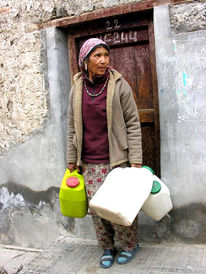The Neighbourhood Project, Old Town Leh
March 2010 – September 2013
The neighbourhood of Old Town, Leh, in which the LAMO Centre is situated, has enormous significance in the history, architectural heritage and current social life of Ladakh. It once constituted the main residential, commercial and public nerve centre of Leh. Prior to the Dogra invasion in the mid-nineteenth century, the royal family occupied the palace and the general public had accommodations of varying sizes and types depending upon their rank in the area below the palace. The area was also home to a bustling marketplace where artisans, craftspeople, producers, traders and vendors set up shop. It was also a hub of cultural and religious life and in its vicinity are located the Namgyal Tsemo monastery, the Jamma Masjid, the royal performing ground, polo ground and later Ladakh’s first cinema house.
The residents of the Old Town are from diverse socio-economic backgrounds. Besides those that belong to Leh’s Buddhist, Muslim, and Christian households, the neighbourhood’s population is also composed of various migrants who have settled in from other parts of Ladakh and Jammu and Kashmir as well as seasonal migrants from other regions of the country who have made the Old Town their home.
The Neighbourhood Project is set against this background, its aim is to document, research, and disseminate the cultural practices of the Old Town in Leh, with a view to revitalizing the creative and diverse heritage of Ladakh. LAMO held household surveys, informal discussions and interviews with residents, recording their memoires and dreams for their neighbourhood, documenting the artistic heritage of the area, responding to it through the creation of contemporary art works, collecting archival and contemporary visuals, making videos, looking at public spaces and commercial establishments, exploring the cuisine, music and clothing, and advocating the importance of the area amongst stakeholders, planners and policymakers.
The project also advocated the importance of Old Town to planners and policy makers. In 2008, the Old Town was declared an endangered site and included on the World Monuments Watch List. Several historic buildings located in the Old Town have been demolished to make way for concrete constructions. At the same time, many of the residents have moved out of the area, their houses abandoned and some declining to a state of ruin.
The project concluded with an exhibition ‘Mapping Old Town Leh: Archival Studies and Contemporary Responses’. The exhibition was curated from the research, archives, artworks and contemporary creations carried out during the last two years of the Neighbourhood Project with a view to advocate the importance of the Old Town, its historic and artistic heritage, and cultural legacy in Ladakh.
Through this project and the exhibition, LAMO’s endeavour is to disseminate the cultural practices of the Old Town of Leh, recognise the community that lives there and exemplify their hopes and aspirations for the regeneration of the Old Town.
The project is supported by the Sir Dorab Tata Trust. The exhibition ‘Mapping Old Town Leh: Archival Studies and Contemporary Responses’ is supported by the Ministry of Tourism and Culture, Jammu & Kashmir.











